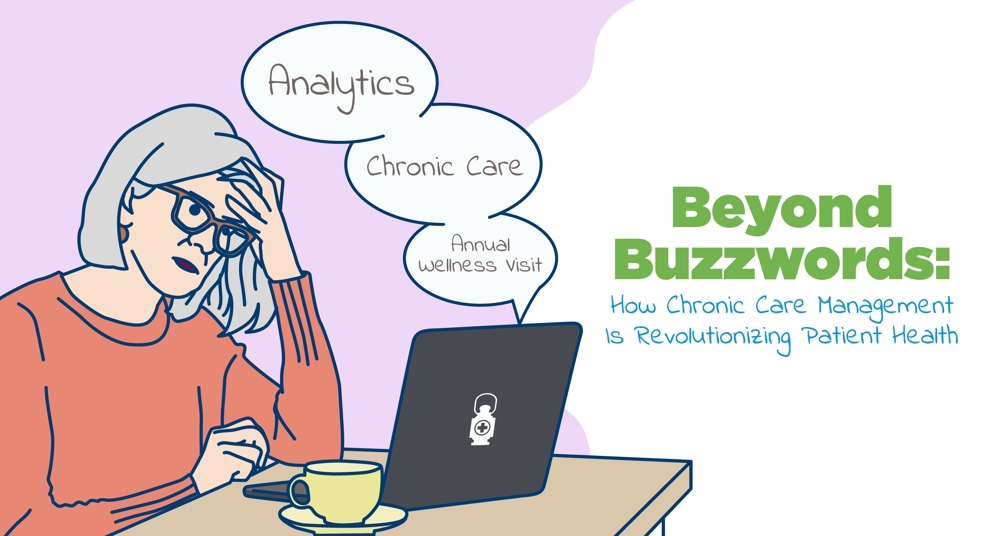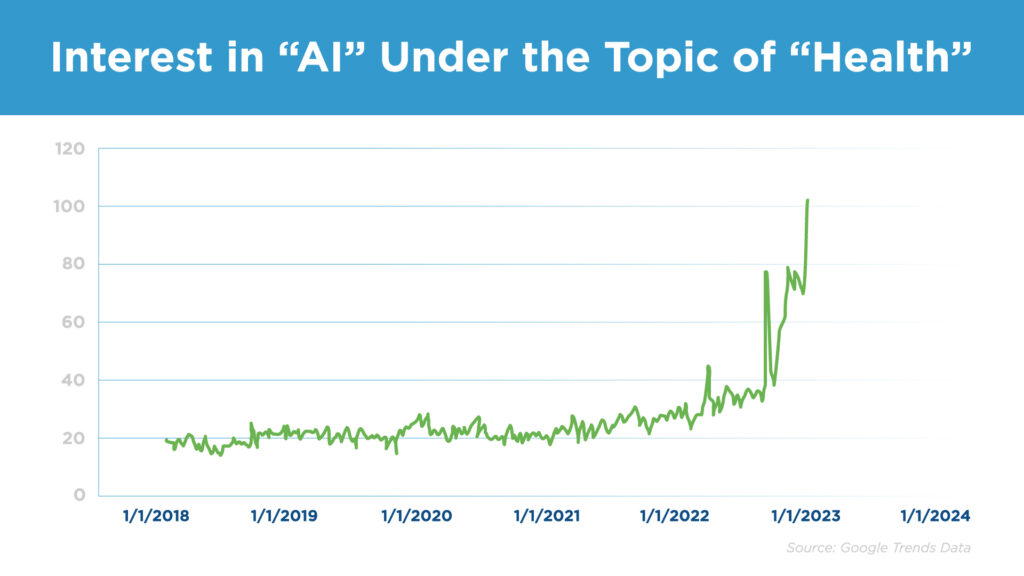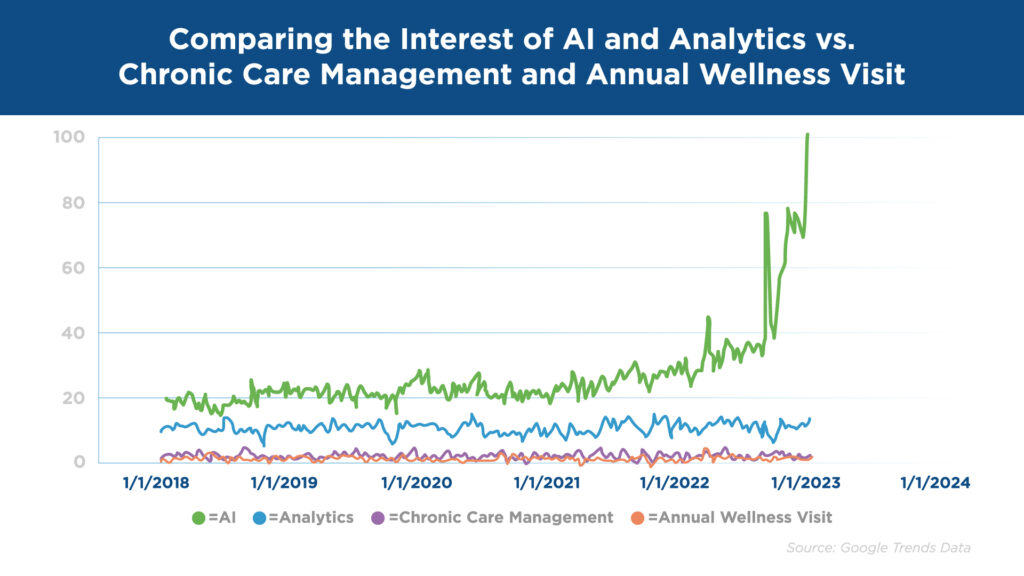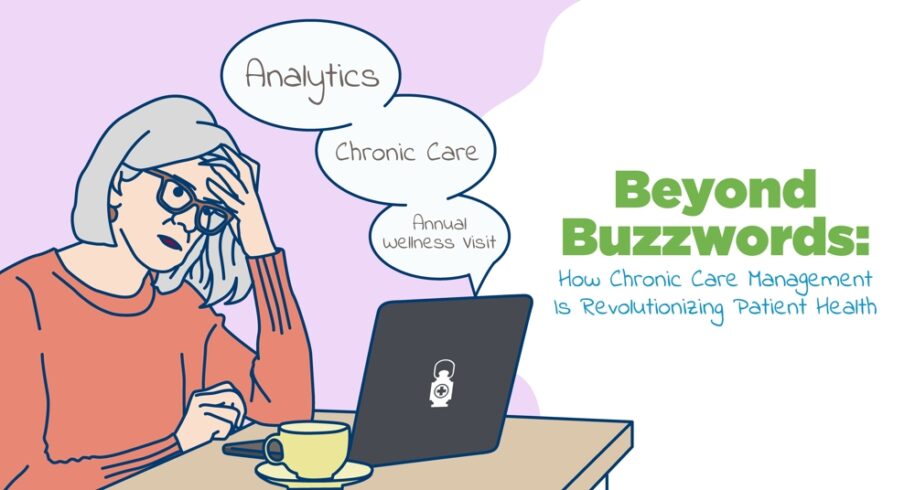
Beyond Buzzwords: How Chronic Care Management Is Revolutionizing Patient Health
Over the past decade, the healthcare industry has been inundated with exciting buzzwords promising to revolutionize the way healthcare is delivered. Words like “analytics”, “AI”, “precision medicine” and “blockchain,” have captured the attention of healthcare professionals, investors, and the media alike.
So, what’s the real story of how these words play a role in healthcare?
Recent Interest in Medical Technology Masks Patients’ Unserved Needs
According to Google Trends data, interest in AI (under the topic of “Health”) has increased by over 470% in the past five years. See the chart below for a breakdown.

However, despite the hype and attention, the reality that these technologies promise is many decades into the future at best. The near-term truth is that they overshadow and distract from the need for fundamental healthcare services and basic resources that most patients are not receiving today.
Instead, investing in making sure your patients are being taken care of could have substantially far more return for both patients and providers. For example, while sophisticated analytics and AI have the potential to improve healthcare delivery and outcomes, they require vast amounts of high-quality data, which is often lacking in many healthcare settings. These technologies are also likely to be expensive to implement, making them inaccessible to many healthcare providers and their patients. Not to mention that those who would benefit the most from innovations in care delivery— such as Medicare chronic disease patients—would also be the most likely to struggle in adopting new technologies.
Improving Patient Outcomes Today with Chronic Care Management
Meanwhile, chronic care management (CCM) is a proven, meaningful service providers can offer right now to their eligible Medicare patients with two or more chronic diseases. Successful CCM programs engage patients longitudinally with dedicated nurse care management resources in between office visits, helping provider organizations deliver more preventative interventions, improving outcomes, and lowering the overall total cost of care.
CCM services have been reimbursable since 2015. CMS even increased CCM reimbursements by as much as 50% in 2022, yet few provider organizations are delivering these services to more than 1-2% of their eligible population.
But even in the face of the immediate impact chronic care management services could have for millions of eligible patients versus that of AI or analytics, interest levels still significantly favor AI & analytics [1].
Patients Are Missing Out On Guaranteed Services Such as Annual Wellness Visits

As illustrated in the chart above, the annual wellness visit (AWV) is another clear example of a basic healthcare service patients are still largely not receiving, but that gets minimal airtime in comparison to these same buzzwords.
AWVs are covered 100% by Medicare, meaning the patient does not have to pay anything out of pocket for the visit (no coinsurance or deductible). For patients, receiving an AWV is a no-cost opportunity to engage with your provider, map out a plan of care to better manage your chronic conditions, and discover if you need further investigation or treatment of any new or existing problem. One study showed that receiving an AWV was associated with a significantly higher likelihood of patients undergoing preventative screenings including mammography, colonoscopy, Pap tests, and bone mass measurements [2].
Similarly, AWVs give providers an easy opportunity to help get patients engaged in their healthcare every year, deliver more preventative medicine to keep patients out of the hospital, and properly document patient diagnosis for purposes of HCC coding, all the while being guaranteed to receive 100% of the reimbursement for the visit.
Yet even though it was introduced by Medicare twelve years ago in 2011, it is estimated that only about 24% of Medicare beneficiaries receive an AWV each year [3].
Rethinking Healthcare Investments
This is the dichotomy currently going on in healthcare: There is a seemingly endless supply of capital, in the form of investments and marketing activities, being allocated to companies and solutions attached to these buzzwords; but what good is the next innovation in healthcare delivery if some of the most fundamental services are currently not being delivered to patients in need?
It’s analogous to installing smart technology in your home when the basic plumbing & electricity isn’t working properly. So while healthcare buzzwords may sound exciting and promising, equal attention should be paid to the need to invest in fundamental, proven resources and services that will benefit providers & patients right now.
Cutting Through the Noise: Why RPM and CCM Matter More Than Ever
While “AI” and “analytics” attract all the attention, programs like Remote Patient Monitoring (RPM) and CCM silently make profound differences in the lives of patients. They connect people with ongoing medical issues with the support, physicians, and care they need to manage their illnesses.
Unlike other, more trendy healthcare systems, RPM makes use of time-proven, easily accessible technologies to keep tabs on patients’ health. And, while a cell phone and a bit of basic testing equipment may not be as glamorous as “precision medicine,” they mean the world to patients working through chronic conditions.
Signallamp Health’s dedicated nurses can help your team provide exceptional care by delivering the essential medical services your patients need. From checking health statuses to suggesting treatments and updating patients’ EMRs, we’re here to help your physicians and other medical professionals provide the services that too many miss out on.
For more about how Signallamp Health can benefit your clinic or healthcare system, contact us to learn everything RPM and CCM have to offer.
Sources:
[1] “Health.” Google Trends. [Online] Available: https://trends.google.com/. [Accessed August 29, 2023]
[2] “The effect of Medicare’s annual wellness visit on preventive care for the elderly.” National Library of Medicine. November, 2018. [Online] Available: https://pubmed.ncbi.nlm.nih.gov/. [Accessed August 29, 2023]
[3] “Hospital utilization and expenditures among a nationally representative sample of Medicare fee-for-service beneficiaries 2 years after receipt of an annual wellness visit.” National Library of Medicine. December, 2019. [Online] Available: https://pubmed.ncbi.nlm.nih.gov/. [Accessed August 29, 2023]

